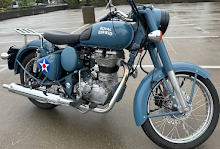 Roads perfect for a Royal Enfield motorcycle are not easy to find here in Florida. Our roads are straight and flat and ruled by big SUVs doing 85 miles per hour.
Roads perfect for a Royal Enfield motorcycle are not easy to find here in Florida. Our roads are straight and flat and ruled by big SUVs doing 85 miles per hour.Thus I have an appetite for "forgotten roads," the rare lost byways that remain as they once were: shady and friendly to vehicles that move at 40 miles per hour.
I was lucky enough to ride just such a stretch of road recently, a bit of Old Dixie Highway locked away from traffic inside the boundaries of a state park north of West Palm Beach.
 The Dixie Highway was the idea of Carl Fisher and was charted 1914, not long after he created the famed Lincoln Highway that runs from coast to coast.
The Dixie Highway was the idea of Carl Fisher and was charted 1914, not long after he created the famed Lincoln Highway that runs from coast to coast.The Dixie Highway ran from the frozen upper Midwest south through the old Confederacy to the orange groves of Florida. This was a full decade before there was a national system of numbered highways.
Fisher didn't lay down any pavement. His Dixie Highway Association simply blazed the trail, painting alternating rings of color around occasional telephone poles to guide the Model T's and motorcycle sidecars south.
It wasn't necessarily the shortest way to get there. Communities along the way were encouraged to buy in to the association, thus reaping the benefit of having the tourists routed through their downtown.
Unlike modern highways, the mighty Dixie was not just one route, north to south: it was a loop, with many connectors, from Detroit south and eventually down the east coast of Florida, across Florida to its west coast and then north by a different path to Chicago. This assured the maximum number of paying communities a chance to get a spot on the route.
In Florida, the eastern leg of the Dixie Highway naturally followed the tracks of the Florida East Coast Railway. That's where the towns were and, besides, the railroad had chosen the highest, driest route that required the fewest bridges. The road alongside the tracks was excellent — for its day.
Today, Old Dixie Highway is mostly like other Florida roads: beset with stoplights and big box stores. But a short length is frozen in time (1950, to be exact).
 That's because, in World War II, the United States built Camp Murphy astride Dixie Highway. Soldiers there learned to operate radar. The soldiers arrived by rail, as did the Top Secret radar equipment. Presumably, having the tracks (and Dixie Highway) at the center of the camp instead of at its edge aided secrecy. Civilian traffic was detoured around to the new Federal Highway to the east.
That's because, in World War II, the United States built Camp Murphy astride Dixie Highway. Soldiers there learned to operate radar. The soldiers arrived by rail, as did the Top Secret radar equipment. Presumably, having the tracks (and Dixie Highway) at the center of the camp instead of at its edge aided secrecy. Civilian traffic was detoured around to the new Federal Highway to the east.Camp Murphy became Florida's Jonathan Dickinson State Park in 1950, with a mission to preserve the almost untouched landscape of Old Florida there. In the process, the state preserved about four miles of Old Dixie Highway within its boundaries.
My friend, screenwriter and wit Douglas Kalajian, has congratulated me on the hypocrisy of writing motorcycle blogs without ever riding my motorcycle. And, it's true, the two-wheeler I rode was a bicycle. No motorized vehicles are allowed on what the park calls its "Paved Bike Path."
 But I have an active imagination, and I hope you do too. The old road had a lot to tell. I expected it to be as straight and flat as the tracks alongside it. Instead, the road follows the contours of the old sand dunes beneath its pavement and its curves swing around the pretty ponds that have filled the borrow pits needed to build up the railroad right of way. Vultures stand guard.
But I have an active imagination, and I hope you do too. The old road had a lot to tell. I expected it to be as straight and flat as the tracks alongside it. Instead, the road follows the contours of the old sand dunes beneath its pavement and its curves swing around the pretty ponds that have filled the borrow pits needed to build up the railroad right of way. Vultures stand guard.The narrow width of the road and the tight radius of its turns would have held motorized traffic here to a casual 35 mph, I am sure. Big trees laden with Spanish moss shade the path. It is an ideal place to ride a Royal Enfield, if only in the imagination.
It ends, as so many things do in Florida, in the artificial terrain of an over landscaped golf course. Sad as that is, it at least guarantees that this stretch of road will remain forever locked in the past.

Here's a map to help you find your way to Florida's Jonathan Dickinson State Park:
View Larger Map

























No comments:
Post a Comment